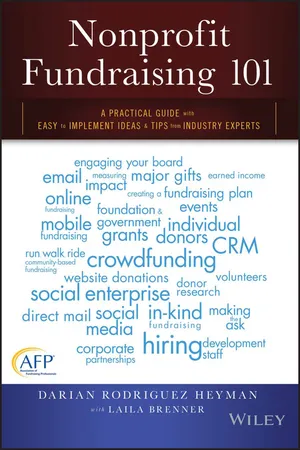
Nonprofit Fundraising 101
A Practical Guide to Easy to Implement Ideas and Tips from Industry Experts
- English
- ePUB (mobile friendly)
- Available on iOS & Android
Nonprofit Fundraising 101
A Practical Guide to Easy to Implement Ideas and Tips from Industry Experts
About this book
Raise more money for your cause!
Based on expert advice and insights from a variety of respected industry experts, Nonprofit Fundraising 101 is an essential text for nonprofit professionals, volunteers, activists, and social entrepreneurs who want to leverage best practices to promote their cause.
Built upon the success of the best-selling Nonprofit Management 101, this easy to digest book provides practical, comprehensive guidance for nonprofit fundraising around the globe. With tips and tools, expert advice, and real-world insights from almost fifty industry leaders, this robust resource addresses the entire spectrum of fundraising for nonprofits, including:
- Planning, hiring, and tracking progress
- Individual donors, major gifts, events, and direct mail
- Board and volunteer engagement
- Foundation and government grants
- Corporate partnerships
- Online and email fundraising
- Social media and mobile crowdfunding
- Earned income and social enterprise
Written by and for front line practitioners and geared towards a global audience of emerging and established leaders, this field guide offers step-by-step formulas for success. Nonprofit Fundraising 101 features a foreword by fundraising guru and Soul of Money author Lynne Twist, insights from notable non-profit professionals such as CNN's Van Jones, and an afterword by Kiva.org Co-Founder & President Premal Shah.
This book also provides indispensible ideas and diverse case studies ranging from grassroots efforts to the ALS Ice Bucket Challenge, and advice for organizations of all sizes and focus. Chapters are brief and easily digestible, featuring extensive resources for additional learning, concrete best practices, and pitfalls to avoid. Enjoy this must-read manual to learn tried and true ways to raise more money for your cause, nonprofit, or charity.
Frequently asked questions
- Essential is ideal for learners and professionals who enjoy exploring a wide range of subjects. Access the Essential Library with 800,000+ trusted titles and best-sellers across business, personal growth, and the humanities. Includes unlimited reading time and Standard Read Aloud voice.
- Complete: Perfect for advanced learners and researchers needing full, unrestricted access. Unlock 1.4M+ books across hundreds of subjects, including academic and specialized titles. The Complete Plan also includes advanced features like Premium Read Aloud and Research Assistant.
Please note we cannot support devices running on iOS 13 and Android 7 or earlier. Learn more about using the app.
Information
Part I
Planning for Success and Preparing Your Team
Chapter 1
Creating a Fundraising Plan
“A goal without a plan is just a wish.”—Antoine de Saint-Exupery
Introduction
Critical Skills and Competencies
1. Understand the Big Picture
2. Know Your Finances
Dispelling the Overhead Myth
- Have staff members break down how they spend a typical week in a spreadsheet. No need to get too specific; simply create 8 to 12 “buckets” for their time, for example, client meetings, fundraising calls, answering email, etc.
- Assign ...
Table of contents
- Cover
- Series
- Title Page
- Copyright
- Dedication
- About the Book
- Acknowledgments
- Foreword Discovering What It Means to Be a Fundraiser
- Part I: Planning for Success and Preparing Your Team
- Part II: Building Your Toolkit and Tracking Progress
- Part III: Individual Donors
- Part IV: Online Fundraising
- Part V: Foundations
- Part VI: Corporate Support
- Part VII: Unlocking Social Enterprise
- Afterword Finding Your Path
- Closing Thoughts
- Book Partners
- About the Authors
- Index
- EULA